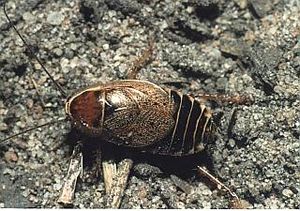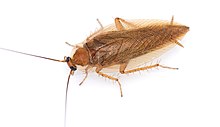Forest cockroaches
| Forest cockroaches | ||||||||||||
|---|---|---|---|---|---|---|---|---|---|---|---|---|

European cockroach, Ectobius sylvestris |
||||||||||||
| Systematics | ||||||||||||
|
||||||||||||
| Scientific name | ||||||||||||
| Ectobiinae | ||||||||||||
| Brunner von Wattenwyl , 1865 |
The forest cockroaches or pleus cockroaches (Ectobiinae) represent a subfamily within the cockroaches (Blattodea). These are approximately 9 to 14 millimeters large animals that feed on decomposing plant parts on the forest floor.
Characteristics of the wood cockroach
The forest cockroaches are about 9 to 14 millimeters long and light brown to brown in color. They resemble the German cockroach ( Blattella germanica ) in their appearance, but are not particularly closely related to it. They differ from these by a uniformly brown neck shield with transparent parts, while that of the German cockroach is opaque brown with two longitudinal stripes.
Way of life
Wood cockroaches are found mainly in spring, summer and late summer in the months of May to October. They live in mixed and deciduous forests and feed mainly on decaying parts of plants. They are active during the day. They prefer loose planting, low bushes and sunny, sheltered and above all warm places. They overwinter in the leaves or in compost heaps .
Unlike their unloved relatives, the wood cockroaches have no known affinity for food in the human household. Wood cockroaches find no food in houses and die there within a few days.
Systematics
The forest cockroaches, however, are a subfamily within the family Ectobiidae (still widely known in sources as Blattellidae. These names were only recently synonymous), to which the following genera are included:
- Arbiblatta Chopard , 1936
- Capraiellus Harz , 1976
- Choristima Tepper , 1895
- Ectobius Stephens 1835 (several species are below / described specified)
- Ectoneura Shelford , 1907
- Phyllodromica fever , 1853 (example species see below )
- Planuncus Bohn, 2013 (e.g. Planuncus tingitanus , see below )
- Pseudectoneura Princis , 1974
- Stenectoneura Hebard , 1943
- Theganopteryx Brunner von Wattenwyl , 1865
At least eight species of wood cockroaches live in Central Europe . The most recently immigrated species is the amber forest cockroach ( Ectobius vittiventris ), which has now reached Germany from Italy via Switzerland. In the Upper Rhine Plain, Planuncus tingitanus, a species of the genus Planuncus originating from North Africa or the western European Mediterranean area, has also established itself since around 2007 .
Sample types of some of the genera listed above:
- Genus Capraiellus:
- Capraiellus panzeri ( Stephens , 1835)
- Genus Ectobius:
- Ectobius erythronotus Burr , 1898
- Common wood cockroach ( Ectobius lapponicus ) ( Linnaeus , 1758)
- Ectobius lucidus ( Hagenbach, 1822)
- Ectobius pallidus ( Olivier , 1789)
- Ectobius sylvestris ( Poda , 1761)
- Amber cockroach ( Ectobius vittiventris ) ( Costa , 1847)
- Ectobius eckerleini Harz , 1977
- Genus Phyllodromica:
- Phyllodromica maculata ( Schreber , 1781)
swell
- ↑ www.blattodea.speciesfile.org - Blattodea's taxonomic database
- ↑ Fauna Europaea Taxonomy (English)
- ↑ Horst Bohn, George Beccaloni, Wolfgang HO Dorow, Manfred Alban Pfeifer (2013): Another species of European Ectobiinae traveling north - the new genus Planuncus and its relatives (Insecta: Blattodea: Ectobiinae). Arthropod Systematics & Phylogeny 71 (3): 139-168. PDF



